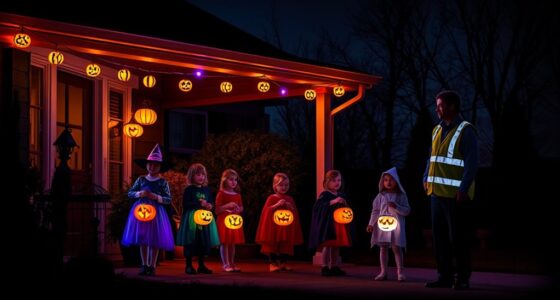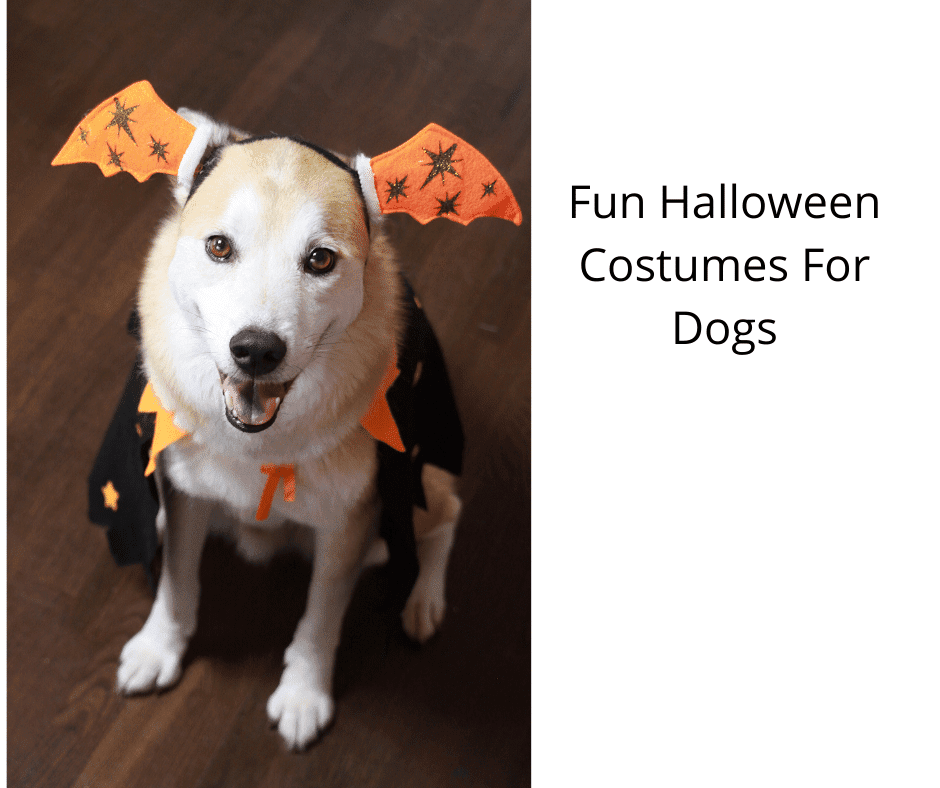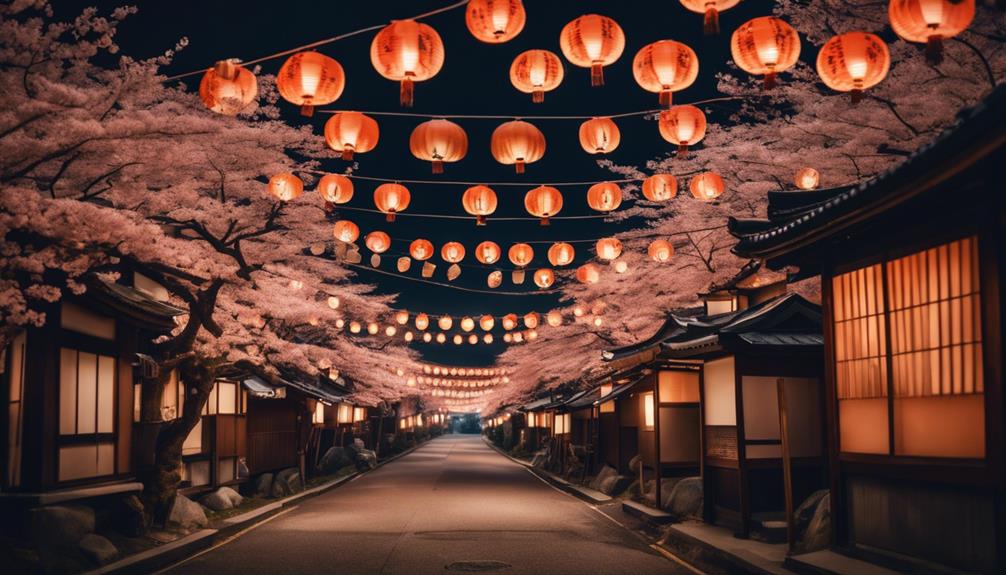Halloween symbols originate from ancient Celtic traditions, used to ward off evil spirits or honor the dead. You’ll see symbols like pumpkins, black cats, bats, and masks, each carrying special meanings—like protecting against evil or representing mystery. Jack-o’-lanterns are believed to guide spirits and keep away harm. If you want to uncover the true stories behind these symbols and understand their significance, keep exploring further.
Key Takeaways
- Halloween symbols originate from ancient Celtic festivals like Samhain, meant to ward off spirits and honor the dead.
- Common symbols include black cats, bats, skeletons, and pumpkins, each representing superstition, mortality, or mystery.
- Jack-o’-lanterns are carved pumpkins used historically as protection and today as festive decorations.
- Black cats, bats, and spiders symbolize mystery, magic, and the night, with cultural variations influencing their meanings.
- Costumes and masks embody disguise, protection, and creativity, connecting to traditional themes of mystery and role-playing.
The Origins of Halloween Symbols

Many Halloween symbols have roots that trace back to ancient traditions and beliefs. Understanding their historical origins helps you see how these symbols developed over time. For instance, many symbols, like pumpkins and masks, carry deep cultural symbolism from Celtic festivals and early rituals. These traditions aimed to ward off evil spirits or honor the dead. The ancient Celts believed that during Samhain, the boundary between the living and the dead blurred, leading to the use of symbols to protect oneself. Over centuries, these symbols evolved into modern Halloween icons, while still retaining their original meanings. Recognizing this connection reveals how Halloween’s symbols are more than decorations—they’re echoes of history, reflecting beliefs and customs from long ago.
Common Symbols and Their Meanings
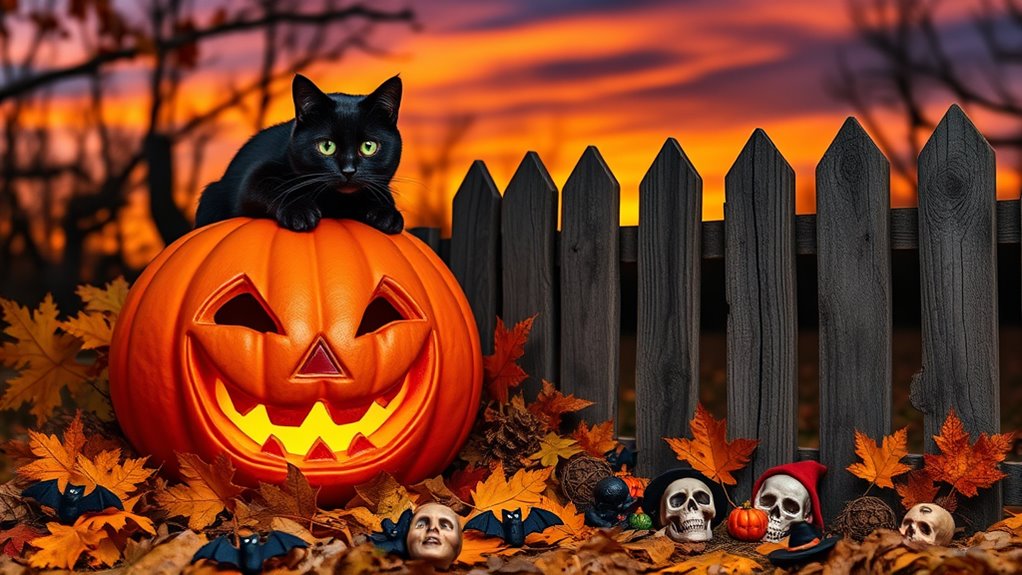
Building on the history behind Halloween symbols, you’ll notice certain images and objects frequently appear during the holiday, each carrying their own meanings. Common symbols include items rooted in witchcraft symbolism and haunted house imagery. These symbols evoke fear, mystery, and tradition. For example, black cats are linked to witches and superstition, while broomsticks symbolize witchcraft. Haunted house imagery often features creaky doors and dark windows, representing the unknown and spooky stories. You’ll also see skulls and skeletons, symbolizing mortality and the afterlife. Additionally, bats are associated with night and darkness, and cauldrons represent magical practices. Recognizing these symbols helps you understand their cultural significance and the stories they tell during Halloween celebrations. Interestingly, some symbols like the black cat are also connected to WWE Raw’s cultural influence, showing how certain images can carry multiple layers of meaning across different contexts.
The Significance of Jack-o’-Lanterns
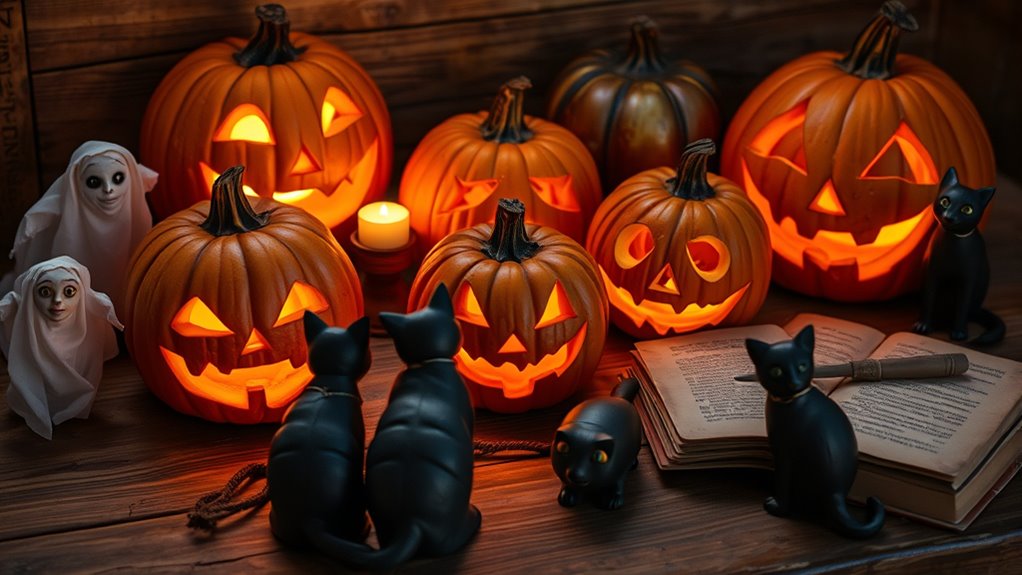
You might already recognize the iconic glow of a Jack-o’-Lantern, but its significance runs deeper than just Halloween decorations. The tradition of pumpkin carving transforms an ordinary pumpkin into a symbol of protection and warding off evil spirits. By hollowing out the pumpkin and carving eerie or expressive faces, you create a vessel for candle illumination, which casts flickering shadows and adds to the spooky atmosphere. Historically, these illuminated pumpkins were believed to guide spirits or keep malicious ones away. Today, they serve as festive symbols of Halloween, showcasing creativity and community spirit. The glowing Jack-o’-Lantern embodies the playful and mystical essence of the holiday, making it a timeless symbol that connects us to ancient customs. Additionally, the practice of mammography for early detection of breast cancer highlights the importance of screening in maintaining health and preventing disease.
Black Cats, Bats, and Spiders: Symbols of Mystery
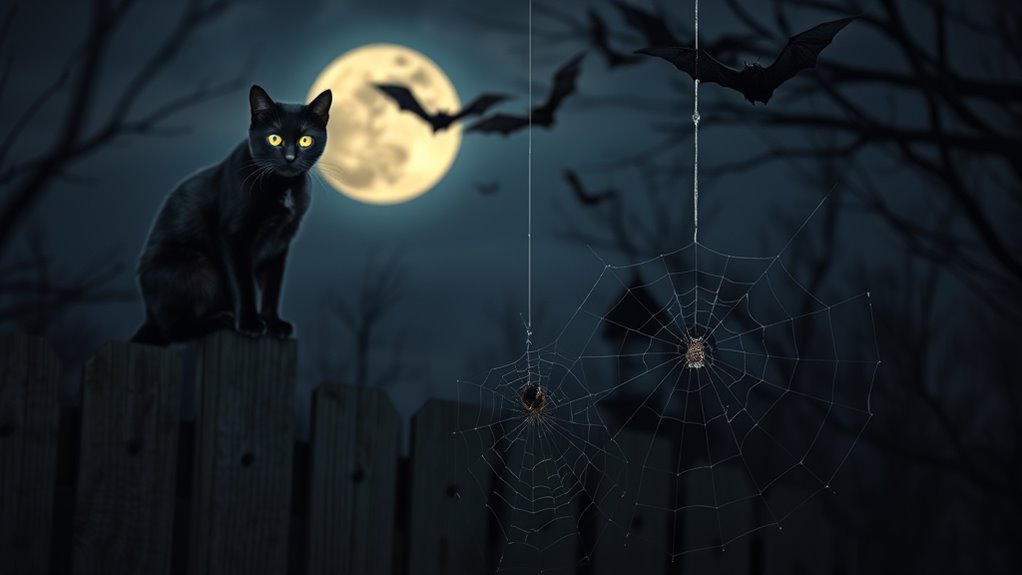
Have you ever wondered why black cats, bats, and spiders are so closely linked to Halloween? These creatures embody mystery and the unknown, fueling superstitions and folklore. Black cats, often seen as omens of bad luck, are tied to superstitions that date back centuries, especially in Europe. Bats symbolize rebirth and passage, with bat symbolism in folklore representing both death and rebirth. Spiders, with their intricate webs, are seen as guardians of hidden secrets and symbols of patience. Understanding these symbols deepens your Halloween experience:
- Superstitions about black cats include both luck and misfortune.
- Bats are believed to carry spirits or represent the night.
- Spiders symbolize mystery and intricate fate.
- In folklore, black cats were thought to be witches’ familiars.
- Bats’ nocturnal nature amplifies their association with the supernatural.
- The cultural significance of these symbols varies across different traditions and stories, enriching the folklore surrounding Halloween.
The Role of Costumes and Masks in Halloween Traditions
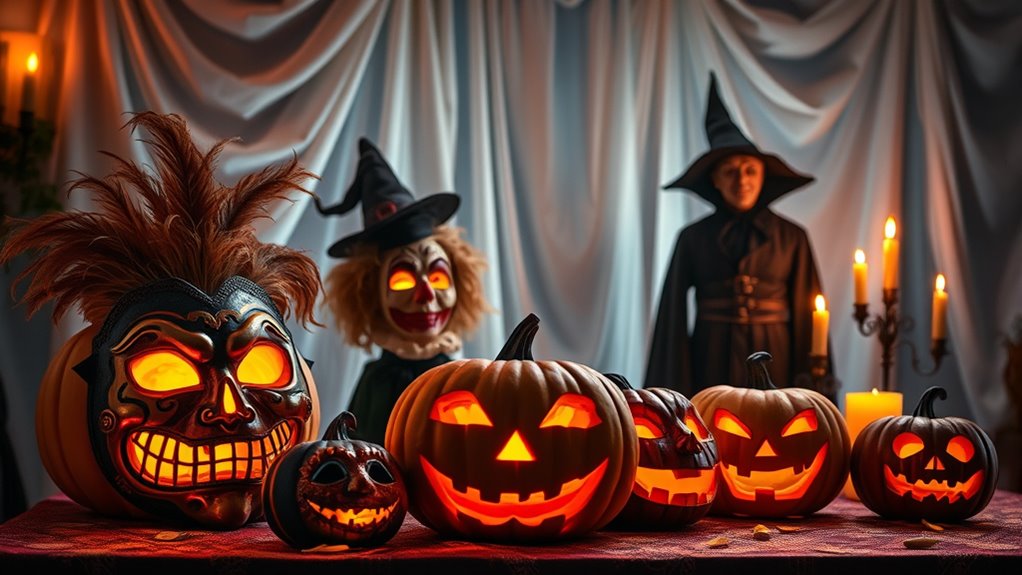
Costumes and masks have long been a central part of Halloween celebrations, transforming ordinary faces into extraordinary personas. They let you explore costume creativity, embodying characters from spooky ghosts to comic heroes. Masks especially hold deep mask symbolism, representing mystery, protection, or the spirit of disguise. Wearing a costume or mask allows you to step outside your everyday identity and enter a world of imagination. The table below highlights common themes: mask symbolism, representing mystery, protection, or disguise.
Frequently Asked Questions
How Did Halloween Become a Global Celebration?
You see, Halloween became a global celebration through its rich history origins and diverse cultural influences. As Irish immigrants brought their traditions to America in the 19th century, the festivities gained popularity. Over time, other countries adopted and adapted Halloween, blending local customs with these influences. Today, its symbols and activities spread worldwide, making Halloween a fun, inclusive event that connects different cultures through shared traditions of costumes, trick-or-treating, and spooky celebrations.
Are Halloween Symbols Connected to Specific Cultural Myths?
It might seem like Halloween symbols are just fun decorations, but there’s often a coincidence connecting them to cultural origins and mythological significance. For example, pumpkins symbolize harvest and protection, rooted in Celtic myths, while black cats are linked to folklore about witches. These symbols reflect deeper cultural myths, showing how ancient stories shape modern celebrations. You’ll notice that many symbols carry layers of meaning rooted in history and myth.
Why Do Some Halloween Symbols Vary by Region?
You’ll notice that Halloween symbols vary by region because regional traditions and cultural adaptations influence their meanings. Different areas incorporate local folklore, history, and customs, shaping unique symbols that resonate locally. For example, some regions emphasize ghosts and spirits rooted in their history, while others focus on harvest-related symbols. This regional diversity reflects how Halloween evolves, blending cultural influences to create distinct celebrations that connect to local identities.
How Have Halloween Symbols Evolved Over Centuries?
Imagine Halloween symbols as a living tapestry, constantly evolving through history. Over centuries, their cultural symbolism has shifted from pagan and religious origins to modern pop culture. You see this change in jack-o’-lanterns, witches, and ghosts, which now blend historical origins with contemporary themes. This evolution reflects society’s changing values, fears, and fantasies, transforming simple symbols into rich, layered icons that connect past and present in festive ways.
Are There Any Superstitions Linked to Halloween Symbols Today?
Yes, there are still superstitions linked to Halloween symbols today. You might believe that seeing a black cat brings bad luck or that knocking on a door at midnight could invite spirits, rooted in superstitions origins. Modern beliefs often blend these old superstitions with fun traditions, making Halloween a night where you’re encouraged to be cautious or embrace playful fears, blending history with contemporary superstition.
Conclusion
Did you know that over 179 million Americans celebrate Halloween each year? Now that you understand the symbols behind the spooky fun, you can appreciate the rich history and meaning behind your costumes, pumpkins, and decorations. Whether you’re carving a jack-o’-lantern or dressing up in a mask, you’re part of a tradition that dates back centuries. So go ahead, enjoy the holiday and embrace its mysterious, fun-filled spirit!


